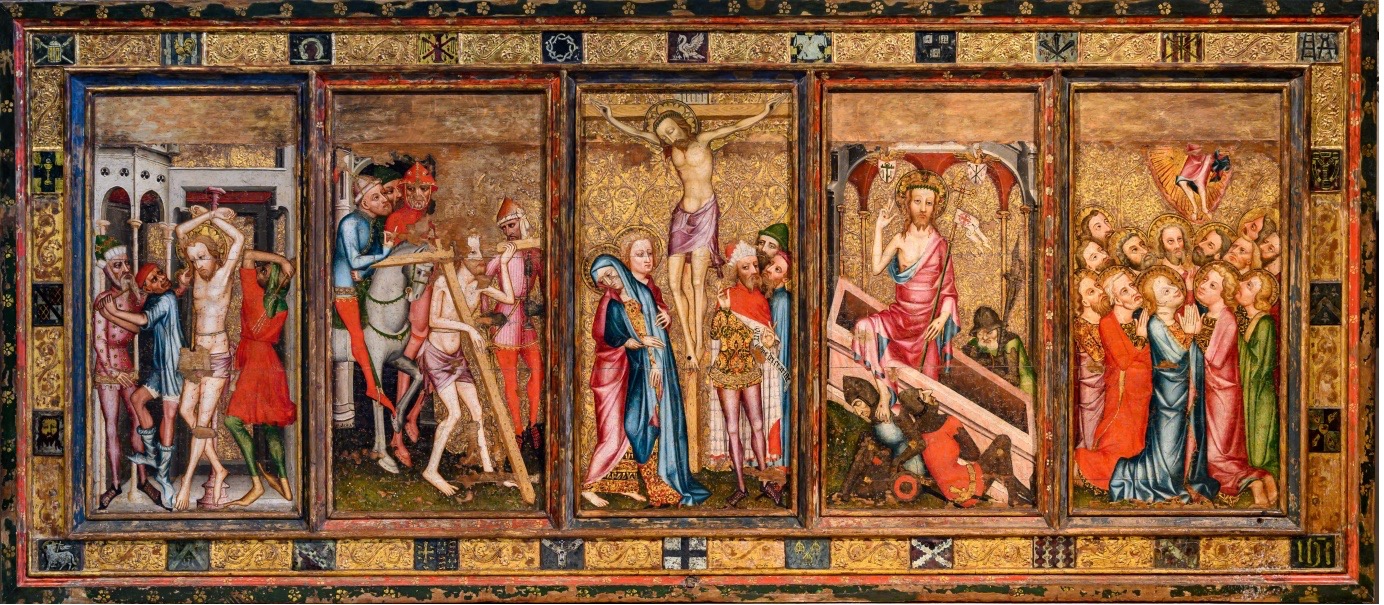 By Revd Canon Ian Morter
By Revd Canon Ian Morter
This weekend the Calendar of the Church’s year steps up to a more intense stage within the season of Lent, as we enter into Passiontide. Passiontide focuses on the last hours of Jesus’ life and his mistreatment at the hands of others. Its name finds its root in the Latin ‘passio’, meaning suffering. In some churches during Passiontide, vestments change colour from Lenten Array (the unbleached linen) to Passion Red (a dark shade). The decorated (jewelled) crosses and statues are veiled and, in places like Westminster Abbey, the beautifully decorated Reredos behind the high altar is also veiled or the doors on a wooden reredos are closed. All of these actions are to emphasise this more solemn period of Lent.
As I have already mentioned, the Passion of Christ focuses on the events of the last hours of Jesus’ life, from his agony in the Garden of Gethsemane to his burial in the Tomb.
In the picture (above), we have The Despenser Retable from St Luke’s Chapel in Norwich Cathedral. This Altarpiece, or Reredos, dates back to around the 1380s and is the only surviving Early English Altarpiece. It was preserved from destruction during the Dissolution of the Monastery by being made into a table with the paintings on the underside. It is a fine example of the medieval art that focused the priest and the worshipper on the passion of Christ from his flagellation and journey to the cross, his crucifixion, and the events that followed his burial – the Resurrection and Ascension.
It is thought to have been commissioned by Henry Despenser, the fourteenth century Bishop of Norwich, and may have originally been sited behind the Cathedral’s high altar.
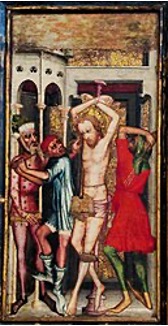 In the first panel from the left, depicted is an almost totally naked Christ, tied to a pillar, being whipped. Jesus, with pale-looking skin, is looking at his persecutors with sadness, rather than in pain. The Roman soldiers are shown as labouring peasants – with sunburnt skin, rustic clothes, and bare legs, and are made to look ugly as they grimace and dance – a sign of their evil intent. There is a bearded authority figure that may represent Pilate.
In the first panel from the left, depicted is an almost totally naked Christ, tied to a pillar, being whipped. Jesus, with pale-looking skin, is looking at his persecutors with sadness, rather than in pain. The Roman soldiers are shown as labouring peasants – with sunburnt skin, rustic clothes, and bare legs, and are made to look ugly as they grimace and dance – a sign of their evil intent. There is a bearded authority figure that may represent Pilate.
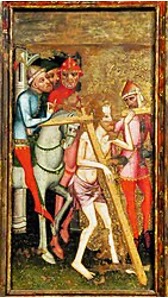 The second panel shows Christ surrounded by soldiers, as he is made to carry his cross though the streets of Jerusalem from Pilate’s house to Golgotha, the place of the crucifixion.
The second panel shows Christ surrounded by soldiers, as he is made to carry his cross though the streets of Jerusalem from Pilate’s house to Golgotha, the place of the crucifixion.
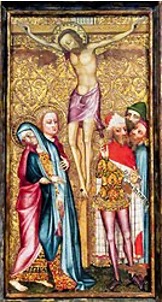 The central panel depicts the crucifixion of Christ. Here we see Mary, the mother of Jesus, being held by St John the Evangelist, the beloved disciple. A group of three men opposite includes a person who may be the same authority figure shown in the scourging scene. There is scroll with a quotation from the Bible which reads “vere filius dei erat iste” or “This man was truly the Son of God”.
The central panel depicts the crucifixion of Christ. Here we see Mary, the mother of Jesus, being held by St John the Evangelist, the beloved disciple. A group of three men opposite includes a person who may be the same authority figure shown in the scourging scene. There is scroll with a quotation from the Bible which reads “vere filius dei erat iste” or “This man was truly the Son of God”.
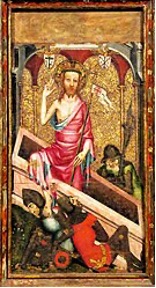 The fourth panel depicts the wondrous Resurrection event of Christ. He is shown carrying the banner of the Resurrection and stepping out of the tomb onto the shoulder of a sleeping soldier as he rises from the grave.
The fourth panel depicts the wondrous Resurrection event of Christ. He is shown carrying the banner of the Resurrection and stepping out of the tomb onto the shoulder of a sleeping soldier as he rises from the grave.
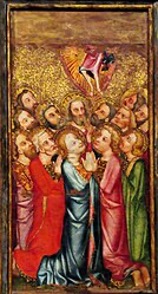 The fifth panel shows the Ascension of Christ, with the Disciples and the Virgin Mary gathered around him. Sadly much of the figure of Jesus is lost, which is the result of the top of the panel being cut away, presumably when the Reredos was made into a table top.
The fifth panel shows the Ascension of Christ, with the Disciples and the Virgin Mary gathered around him. Sadly much of the figure of Jesus is lost, which is the result of the top of the panel being cut away, presumably when the Reredos was made into a table top.
The frame which surrounds the Reredos has a number of heraldic shields. The significance of them is disputed, including which families they represent. But, more important to us, as we consider this devotional work of art, are the shields that depict the instruments of Christ’s passion “Arma Christi”. The primary ones are: the crown of thorns; the column and the whip for the flagellation; the nails of the cross; the spear; the reed with the sponge; and Veronica’s veil. But I can also identify the seamless garment stripped from Jesus, the ladder. There are also the symbols of The Pelican in her Piety (feeding you from blood drawn from her breast) and The Agnus Dei (Lamb of God), which speaks of Christ being our Saviour.
This beautiful, vibrant and colourful Reredos help us to consider more vividly the passion of the suffering of Christ, as we enter into Passiontide.
Image copyright: Bill Smith/Norwich Cathedral.
My thanks to Emma Knights of Norwich Cathedral who kindly sent me the picture of The Despenser Retable and the permission to use it in this article.